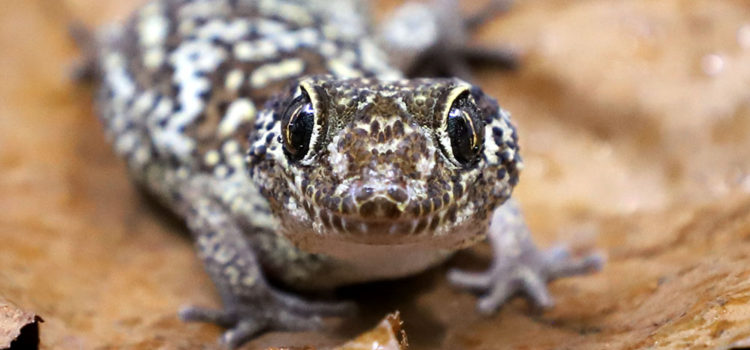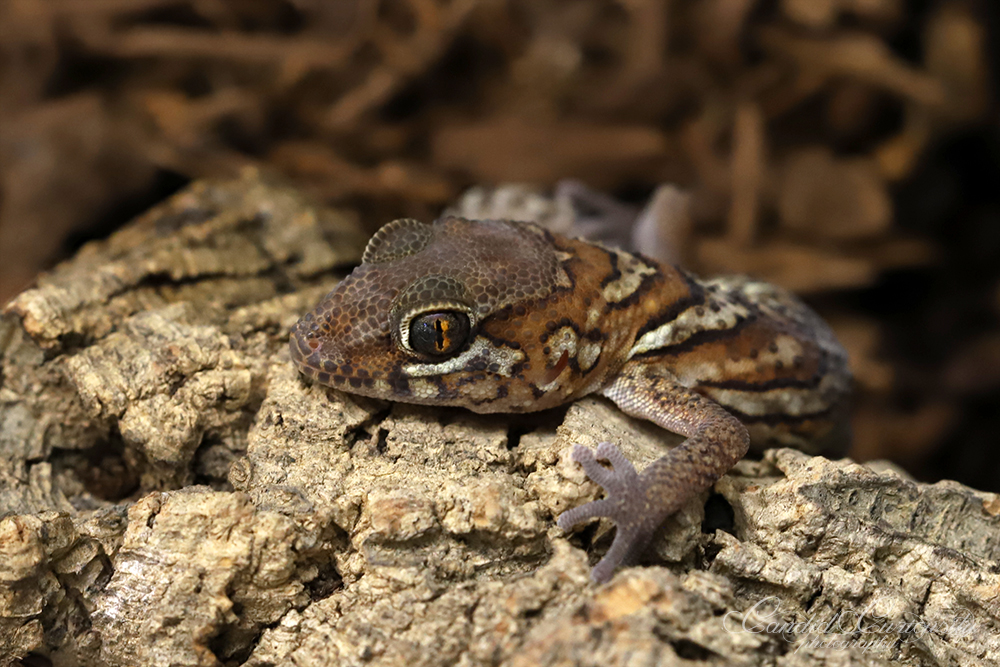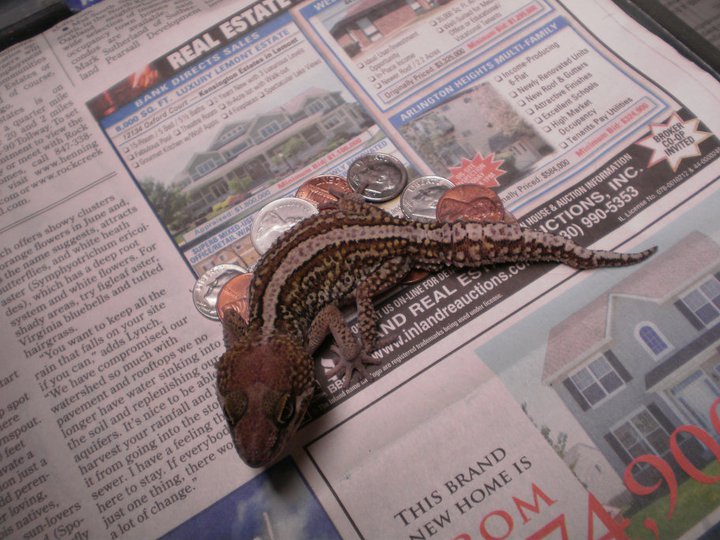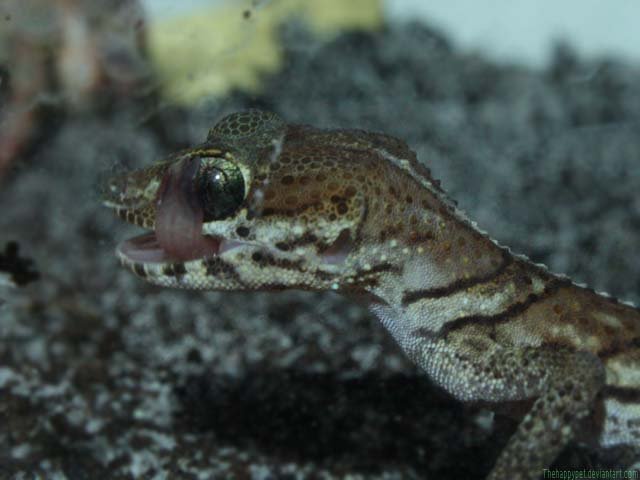
Pictus geckos originate in the spiny forests of Madagascar, are rewarding to keep, and easy to care for when housed individually.

Housing
Pictus geckos are small, insectivorous, animals reaching a length of only 4-6 inches, but can be very active, and become very sociable if raised in an area where they can see people outside their enclosure.
I have used several setups for my pictus geckos over the years. I’ll walk you through several successful setups ranging from naturalistic to minimalistic.
The naturalistic setup I have created in both 10 and 20 gallon forms. A 20L aquarium provides about 30″ by 12″ of floor space with about 13″ of height. I utilize both Zoomed brand reptisand, which is a natural quartz sand, and Zilla brand Jungle Mix soil in an attempt to recreate a part of the pictus geckos natural habitat. In the naturalistic setup I use both overhead heat to warm the air and provide ambient heat, and under tank heating to provide a warm retreat that is always available. UVB lighting is beneficial to both live plants, and geckos, though many keepers decline to use it with their crepuscular and shade dwelling species such as pictus geckos. I have used waterfalls in these setups as well, and the geckos have seemed to appreciate the running water, spending a lot of time in and around the falls. Fake plants, arranged around the hardscape of sturdy rock and wood pieces, add beauty to the habitat and add enrichment opportunities for the geckos. If you take advantage of the height the geckos will use it. Offer places to explore, hunt, and hang out in safety. As far as live plants go pothos species did very well in these slightly arid habitats.
In a minimalistic setup you can use a plastic tote, typically in smaller sizes then the naturalistic habitats as there is less cage decoration to fill the space. Paper towel makes a simple substrate that is easy to clean, and easy to monitor for urates and feces. A water dish can be made of ceramic or plastic for easy sanitization. A plastic deli cup with a hole cut in the top or side and stuffed with sphagnum moss makes a great humid hide. Plastic or silk plants can fill the rest of the space and make your gecko feel more comfortable. In the smaller plastic totes I have found that a heating pad approximately 1/4 to 1/3 of the total surface area in size is enough to maintain temperatures in most instances.

Heat and Light
A moderate hot spot in the mid to upper 80’s can be achieved with a small,
low wattage heat lamp. Overhead heating will boost air temperatures and raise ambient temperatures in the enclosure over room temperature. A heat pad works well as a supplemental source of heat in naturalistic enclosures, and as an only source of heat in shallow plastic totes or rack systems. We usually aim for a range in the enclosure from about 75-90 degrees, though in a larger enclosure a broader range works well. Although considered nocturnal by the reptile keeping hobby, they are active at both dusk & dawn and are likely to have access to levels of UV in the wild during this time, so I provide UVB lighting running the length of the enclosure. UVB lighting also has scientifically known benefits in captive populations of leopard geckos, which suffer from many of the same ailments in captivity as pictus geckos.

Bedding
Paper towel is a simple, easy cage lining to use for babies and egg laying females and assures you that they are feeding, and pooping, the way they should. We have also used reptile cage carpet with success. For a more naturalistic enclosure we love to use Zilla’s Jungle Mix, which is a combination soil substrate unlike coco coir which is just ground coconut shells. Depending on humidity needs we may utilize sphagnum moss as well, it looks very natural in the enclosure, and doesn’t mold. Isopods and springtails added to the substrate can act as a natural cleaner crew as well.
Environmental enrichment
A water dish no more then an inch or two deep, they aren’t great swimmers, but as wide as you think looks good in their tank, will keep them hydrated. A moist hide filled with sphagnum moss will aid with shedding and give them a shady place to hang out and sleep in during the day. Some textured logs like cork, mopani, or grapewood offer climbing and hiding opportunities for your geckos. Foliage, whether live or fake, offers a bit of cover in otherwise empty, flat, and open areas of the tank. Being small animals they tend to hug corners and travel under vegetation and fallen debris. The more décor items in their cage, the more active and confident they tend to be. Though once they are settled in, most will run right up to the front of the cage and put their paws on the glass, begging for food and attention!

Food
Mealworms, crickets, dubia, waxworms, hornworm, small super worms, and even isopod species like dwarf white or powder orange, are suitable insect feeders for pictus geckos. Dust calcium every feeding, multivitamin/D3 once weekly.
We feed dubia and mealworms from disposable dishes made of plastic that come with a lip around the edge that prevents the insects from escaping. The geckos become acquainted to these dishes and will stake them out and “hunt” around them when they are hungry. We also put calcium into these dishes to allow the geckos to free feed from it at any time. Ceramic dishes, with their slick sides, work for this as well if deep enough to provent the bugs from getting out. This also turns our cricket feedings into environmental enrichment for our geckos and an opportunity to dust with multivitamins.
Many breeders do the opposite and use crickets as a staple while rotating in worms. Either method seems to work equally well as long as food is offered at frequent intervals and is properly dusted.
Cohabitating and breeding
Today we house our adult pictus geckos individually in their own enclosures to avoid any sort of competition or stress. Males must be housed separately as they will fight any other males in the same enclosure. Females can sometimes be successfully housed together given enough space, and equal access to basking areas, food, and water. We raise our hatchlings in sibling pairs until they show signs of needing to be separated, this can include one sibling growing much larger or faster then the other, or one sibling turning male. Males can be ready to breed at an exceptionally young age which would be detrimental to a young, growing female. Once our young geckos are separated they are maintained separately unless introduced for breeding.

Further reading:
- http://www.reptilesmagazine.com/How-to-Care-For-The-Madagascar-Ground-Gecko/
- http://www.thegeckospot.net/pictuscare.php
- http://www.supremegecko.com/pictus-gecko-care-sheet
- http://www.supremegecko.com/paroedura-picta-caramel-albino-what-are-the-odds
- http://www.supremegecko.com/paroedura-picta-of-the-spiny-forest
